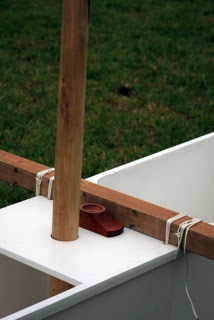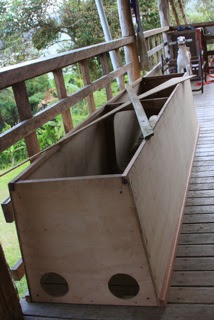Our family took this whole week off after Christmas... well mostly off. Still had some little work things that came up but all in all it was a decent week off. So I managed to get Shan Skailyn's hull, iakos and ama completely painted! The paint job is finally done!!! That was a huge job!
So check it out! Shan Skailyn in all her slightly gaudy, painted glory! Our two older girls and some visiting friends were quite excited to play with 'Rusty' the tree kangaroo in the boat.
Even though I just used exterior acrylic paint, I'm thinking that with the 4 coats of primer and at least 3 top coats (the red needed more to keep the primer from showing through) that the paint job ought to hold up a good long time. I sanded in between all the primer coats (not the top coats) which helped produce a nice smooth finish overall.
One little tip for any other would be boat painters out there. If you're not using masking tape and still wanting some fairly clean lines in your paint job, use a little edge painter like the one I used. I actually had masking tape but on the pieces I tested it on it just was leaving a ton of hard to remove junk and the adhesive was just too strong. I was worried it was going to remove paint. So I first opted to hand paint the lines in using some little artist paint brushes we had on hand. S-L-O-W! Also, the lines were still too ragged for my taste. That's when I rummaged through my supply cabinet and found that I had this little edge painter. It's just a flat pad, with lots of short, soft bristles and a little grip on the backside. It's made for painting right up into corners with no mess and no masking. I decided to try it and was blown away by how smoothly it lays down paint... no bubbles, hardly any streaks... just smooth. It also makes it so much easier to paint a nice clean straight edge. Everything about this little device really made it the perfect applicator for the whole paint job (except for filleted corners). So I used it for everything once I discovered I had it. Can I say again that this thing laid down a super clear coat? Better than any roller or paintbrush I've ever used. I think a sprayer probably would have done better, but for the low budget people, this thing is a treat! Get one for your boat!






















































